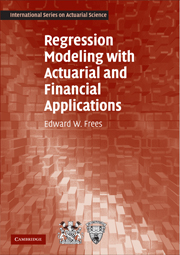Book contents
- Frontmatter
- Contents
- Preface
- 1 Regression and the Normal Distribution
- Part I Linear Regression
- Part II Topics in Time Series
- Part III Topics in Nonlinear Regression
- Part IV Actuarial Applications
- 16 Frequency-Severity Models
- 17 Fat-Tailed Regression Models
- 18 Credibility and Bonus-Malus
- 19 Claims Triangles
- 20 Report Writing: Communicating Data Analysis Results
- 21 Designing Effective Graphs
- Brief Answers to Selected Exercises
- Appendix 1 Basic Statistical Inference
- Appendix 2 Matrix Algebra
- Appendix 3 Probability Tables
- Index
16 - Frequency-Severity Models
Published online by Cambridge University Press: 05 June 2012
- Frontmatter
- Contents
- Preface
- 1 Regression and the Normal Distribution
- Part I Linear Regression
- Part II Topics in Time Series
- Part III Topics in Nonlinear Regression
- Part IV Actuarial Applications
- 16 Frequency-Severity Models
- 17 Fat-Tailed Regression Models
- 18 Credibility and Bonus-Malus
- 19 Claims Triangles
- 20 Report Writing: Communicating Data Analysis Results
- 21 Designing Effective Graphs
- Brief Answers to Selected Exercises
- Appendix 1 Basic Statistical Inference
- Appendix 2 Matrix Algebra
- Appendix 3 Probability Tables
- Index
Summary
Chapter Preview. Many datasets feature dependent variables that have a large proportion of zeros. This chapter introduces a standard econometric tool, known as a tobit model, for handling such data. The tobit model is based on observing a left-censored dependent variable, such as sales of a product or claim on a health-care policy, where it is known that the dependent variable cannot be less than zero. Although this standard tool can be useful, many actuarial datasets that feature a large proportion of zeros are better modeled in “two parts,” one part for frequency and one part for severity. This chapter introduces two-part models and provides extensions to an aggregate loss model, where a unit under study, such as an insurance policy, can result in more than one claim.
Introduction
Many actuarial datasets come in “two parts:”
One part for the frequency, indicating whether a claim has occurred or, more generally, the number of claims
One part for the severity, indicating the amount of a claim
In predicting or estimating claims distributions, we often associate the cost of claims with two components: the event of the claim and its amount, if the claim occurs. Actuaries term these the claims frequency and severity components, respectively. This is the traditional way of decomposing two-part data, where one can consider a zero as arising from a policy without a claim (Bowers et al., 1997, Chapter 2).
- Type
- Chapter
- Information
- Regression Modeling with Actuarial and Financial Applications , pp. 417 - 432Publisher: Cambridge University PressPrint publication year: 2009

